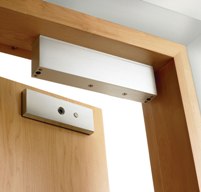 The term “mag lock” might seem pretty self-explanatory – a magnetic lock. However, mag locks actually consist of an electromagnetic lock that is only operational with power applied. Battery backups are very necessary, especially if the mag lock is the only thing securing your door. With so many locks to choose from, it’s important to do your research. While all locks have the same purpose of locking a door or a safe, some are a better fit for particular facilities than others.
The term “mag lock” might seem pretty self-explanatory – a magnetic lock. However, mag locks actually consist of an electromagnetic lock that is only operational with power applied. Battery backups are very necessary, especially if the mag lock is the only thing securing your door. With so many locks to choose from, it’s important to do your research. While all locks have the same purpose of locking a door or a safe, some are a better fit for particular facilities than others.
Mag Locks -How They Work
The most common place for a mag lock to be installed is in the top outer corner of the door frame. An armature plate is then attached to the top outer corner of the door itself. When the door is closed, the mag lock and the plate are in contact and connected by magnetic force. Once they’re energized, a current will pass through the electromagnet inside the lock; this then attracts the armature plate with such strong force, the door consequently locks in place.
There should be a separate release button mounted near the door to cut power supply to the lock since mag locks don’t actually interact with levers or other door hardware. The release button will ensure compliance with NFPA fire codes which is crucial. A motion sensor or crash bar with an internal switch should be used to unlock the door on the egress side automatically – this is what will ensure compliance with fire code.
Mag Locks – Complying with Code
Mag locks can be a little tricky when it comes to complying with code. If your local Authority Having Jurisdiction (AHJ) allows you to install a mag lock, he/she will require electrical plans and permits.
With a multitude of codes, finding appropriate applications for a mag lock can be a little difficult. They work really well when it comes to integration into access control systems as well as in facilities that don’t handle a lot of free egress. Detention centers and correctional facilities are two examples of facilities where mag locks would work well.
Mag Locks – The Details
There are two types of mag locks – fail-secure and fail-safe. With a fail-safe lock, when power is lost from the device, the lock de-energizes and releases, allowing free access. There are times where high-security facilities want to use fail-safe locks, but there’s a fear that if power is easily disrupted, the locks are no longer active. To combat this weakness, high-security facilities using fail-safe locks should only use them in conjunction with a magnetic bond sensor and a power supply that includes battery backup capability.
When you have a fail-secure lock, if power is lost to the device, the door remains magnetically locked. Regardless of how hard you try, if there’s no power that lock isn’t going to release.
Mag Locks – The Final Word
At the end of the day, aside from your AHJ’s ruling, you have to decide if using a mag lock will be productive for your facility. If this is something you feel will work, they’re a great product. On the other hand, if you’re finding too many issues with code compliancy and the mechanics of making a mag lock work, it might be a better idea to stick with a different type of locking system.
